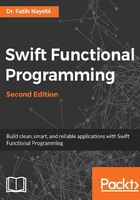
Higher-order functions
As we have seen in the Defining and using function parameters and Function types sections of this chapter, functions can accept functions as parameters in Swift. Functions that can accept other functions as parameters are called higher-order functions. This concept, along with first-class functions, empowers FP and function decomposition.
As this topic is essential in FP, we will go through another simple example.
Suppose that we need to develop two functions that add and subtract two Int values as follows:
func subtractTwoValues(a: Int, b: Int) -> Int {
return a - b
}
func addTwoValues(a: Int, b: Int) -> Int {
return a + b
}
Also, we need to develop functions to calculate the square and triple of two Int values as follows:
func square(a: Int) -> Int {
return a * a
}
func triple(a: Int) -> Int {
return a * a * a // or return square(a) * a
}
Suppose we need another function that subtracts the two squared values:
func subtractTwoSquaredValues(a: Int, b: Int) -> Int {
return (a * a) - (b * b)
}
In case we needed to add two squared values:
func addTwoSquaredValues(a: Int, b: Int) -> Int {
return (a * a) + (b * b)
}
Let's say that we need another function that triples a value and multiplies it with another tripled value:
func multiplyTwoTripledValues(a: Int, b: Int) -> Int {
return (a * a * a) * (b * b * b)
}
This way, we had to write a lot of redundant and inflexible functions. Using higher-order functions, we could write a flexible function as follows:
typealias AddSubtractOperator = (Int, Int) -> Int
typealias SquareTripleOperator = (Int) -> Int
func calculate(a: Int,
b: Int,
funcA: AddSubtractOperator,
funcB: SquareTripleOperator) -> Int {
return funcA(funcB(a), funcB(b))
}
This higher-order function takes two other functions as parameters and uses them. We can call it for different scenarios as follows:
print("The result of adding two squared values is: \(calculate(a: 2, b: 2, funcA: addTwoValues, funcB: square))")
// prints "The result of adding two squared value is: 8"
print("The result of subtracting two tripled value is: \(calculate(a: 3, b: 2, funcA: subtractTwoValues, funcB: triple))")
// prints "The result of adding two tripled value is: 19"
This simple example presented the utility of higher-order functions in function composition and subsequently in program modularity.